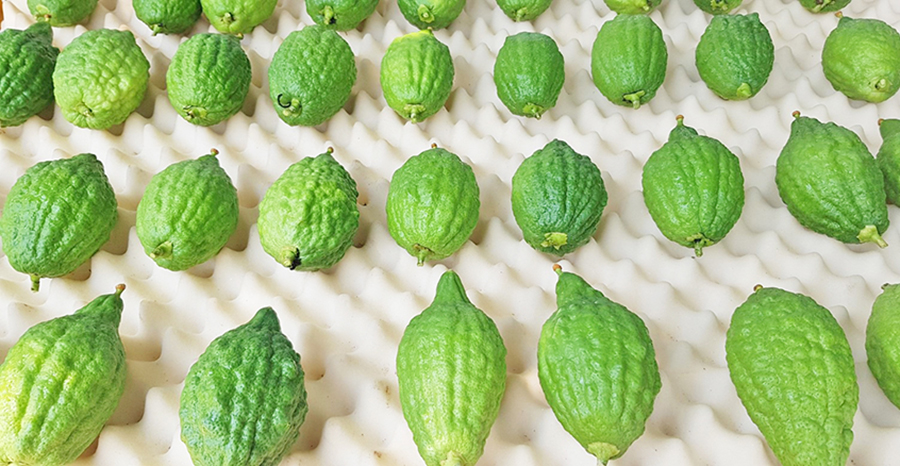What does harvesting esrogim entail? How many months of work is required? What percentage come out kosher? These questions and more were answered in a recent Jewish Press interview with esrog grower Haggai Kirshenbaum, owner of the Kirshenbaum Esrog Company, and Tzvi Kirshenbaum (no relation), the company’s packing manager. The two took turns answering questions in between non-stop telephone calls, demanding customers, and worker interruptions.
The Kirshenbaum Esrog Company was founded by Haggai’s great-grandfather 140 years ago. The historic esrog orchard the family oversees is located on Moshav Yishresh near Rechovot.
‘);
_avp.push({ tagid: article_top_ad_tagid, alias: ‘/’, type: ‘banner’, zid: ThisAdID, pid: 16, onscroll: 0 });
The Jewish Press: What do you need to be a successful etrog farmer?
Kirshenbaum: A lot of siyata d’shamaya. Growing etrogim isn’t like growing apples or oranges which you just throw into a crate and send off to market. You need etrogim that are clean and shapely, without any blemishes. Some customers demand a perfect pitam and shoshana. If a fruit isn’t kosher, it goes into the dump.
Do etrog trees bear fruit only once a year?
The etrog is the only pri hadar that produces fruit five times annually. For Sukkot, we keep only the last three harvests. The other two are used to make jam, for animal feed, or are destroyed.
Can etrogim be damaged while they’re still on the tree?
Yes. Leaves with thorns have to be kept away from the fruit. Birds aren’t a problem, but trees need to be sprayed with pesticides every day to guard against insects.
A cold springtime can also damage the harvest. Cold and frost puts the trees to sleep and they don’t bear fruit, G-d forbid. If there’s a severe winter drought, we can counteract it with watering the orchards ourselves.
What percentage of the etrog harvest turns out to be kosher for the holiday?
Approximately 80 percent.
How is the kashrut of the etrogim determined?
When the fruit reaches our warehouse, we have 15 rabbis who carefully inspect every etrog. Every boxed etrog comes with a certificate of kashrut.
How many etrogim do you send to market each year?
300,000.
What percent of the fruit is exported?
Forty percent.
Who determines the price?
The rabbis sort the etrogim into different levels – kosher, mehudar, and super mehudar. Prices are based on those categories.
How many large etrog producers are there in Israel?
About 15.
In what other countries are etrogim grown?
Morocco and Italy. A little in Mexico and Australia. Most of the etrogim bought overseas come from Eretz Yisrael. By buying an etrog from Israel, people get a double reward in performing the mitzvah of arba minim; they also fulfill the mitzvah of settling Eretz Yisrael.
Does Kirshenbaum also grow lulavim?
No. We don’t have time.
What do you do in the off-season?
The etrog business is an all-year occupation. We hire more workers as the summer harvest approaches and in Elul, but managers are kept busy throughout the year.
What would you say is the biggest satisfaction you derive from this business?
When I daven Shacharit at the Kotel during Chol HaMoed and see all the etrogim – knowing that many of them come from our groves gives me a feeling of elation.
Is there a difference between the etrogim you grow and the etrogim your great-grandfather grew?
Today we can be more certain that an etrog doesn’t come from a grafted tree. Otherwise, an etrog is an etrog.
What advise would you give to the general public about buying an etrog?
Rebbe Nachman [of Breslov] told his students to pray on Rosh Hashanah for a beautiful etrog on Sukkot. A famous rabbi in Jerusalem would always purchase his etrog from us before Yom Kippur. After the fast and Havdalah, he would hold the etrog in his hands, lift it to his heart, and cry with joy for 10 minutes.
The etrog is the heart. When we grow and pick etrogim off the trees, we treat them with extra sensitivity and care, and so should the buyer. When we wave the arba minim before Hashem, we want to do it with a full heart and with a nice-looking etrog. Kosher is kosher, but why not spend another few shekels for a heart that’s mehudar?
<!–
Publisher #16: JewishPress.com
Zone #113: Comment Banner / (02) / News
Size #15: Banner 468×60 (Comments and Mobile) [468×60]
–> ‘);
_avp.push({ tagid: article_top_ad_tagid, alias: ‘/’, type: ‘banner’, zid: ThisAdID, pid: 16, onscroll: 25 });




